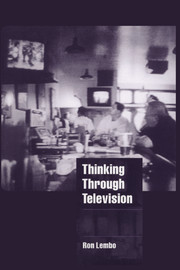Book contents
- Frontmatter
- Contents
- Acknowledgments
- Introduction: Situating my experience with television
- PART I Conceptions of television use
- PART II Reconceptualizing television use
- PART III Documenting the viewing culture
- 6 Methodology and the turn to television
- 7 The practice of viewing
- 8 A typology of television use
- Conclusion: The politics of television reconsidered
- References
- Index
8 - A typology of television use
Published online by Cambridge University Press: 22 September 2009
- Frontmatter
- Contents
- Acknowledgments
- Introduction: Situating my experience with television
- PART I Conceptions of television use
- PART II Reconceptualizing television use
- PART III Documenting the viewing culture
- 6 Methodology and the turn to television
- 7 The practice of viewing
- 8 A typology of television use
- Conclusion: The politics of television reconsidered
- References
- Index
Summary
In this chapter, I construct a typology of television use. In formulating this typology, my intent is to bring together important aspects of the analysis I presented in the previous two chapters with additional documentation of viewing practices gleaned from the interview accounts and my participation in the viewing culture. I want to provide the reader with a way of understanding the relationship between the routines that people have established in turning to television on a daily basis and the specific, mindful ways in which they typically became involved with programming. In doing so, I want to make explicit how these viewing practices are situated amidst and shaped by the broader meaningful context that is people's everyday life. To a certain extent, I have already done this, especially in my discussion of the turn to television. In chapter 4, the very notion of a turn to television incorporated the idea that work, family life, household responsibilities, hobbies, and other free-time pursuits were significant factors that shaped in various ways the mindfulness with which people brought television into their lives on a day-to-day basis. In chapter 5, the sociality of viewing itself took center stage, but the lives people led outside of the viewing culture continued to play a role in shaping what they did with television.
- Type
- Chapter
- Information
- Thinking through Television , pp. 215 - 231Publisher: Cambridge University PressPrint publication year: 2000

